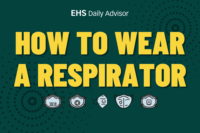Safety is a process, and as such, needs to be managed. This section offers resources to create a viable safety program, sell it to senior management, train supervisors and employees in using it, and then track and report your progress. Look also for ways to advance your own skills in these areas, both for your current job, and those that follow.
On this week’s episode of EHSDA Shorts, we hear from Adele Abrams, President of the Law Office of Adele L. Abrams, P.C., on her thoughts about core values companies should keep in mind when developing safety programs. Tune in to hear her insights.
Eye and face protection is essential for many workers as part of their personal protection equipment (PPE). According to OSHA, thousands of employees are blinded each year from work-related eye injuries that are preventable with the proper equipment. Eye and face protection must be provided when necessary to protect workers from chemical, environmental, radiological, or mechanical […]
Back to Basics is a weekly feature that highlights important but possibly overlooked information that any EHS professional should know. This week, we examine OSHA’s requirements for eye and face protection. Eye and face protection is essential for many workers as part of their personal protection equipment (PPE). According to OSHA, thousands of employees are […]
On November 28, the Quality, Safety & Oversight Group of the Centers for Medicare and Medicaid Services (CMS) urged healthcare industry leaders to take steps to protect healthcare workers from workplace violence. Recommended steps to prevent workplace violence in hospitals include ensuring workers receive adequate training, having sufficient staffing levels, providing ongoing assessment of patients […]
Even prior to the pandemic, worker burnout was a major concern for businesses. It remains a high priority as workers struggle with stress and other pressures and organizations struggle with workforce retention. Share your feedback on this topic by taking this survey, which focuses on the causes of worker burnout and how organizations can help […]
Millions of employees are required to wear respirators, and compliance with OSHA’s respiratory protection standard can help avoid thousands of illnesses and hundreds of deaths every year. OSHA provides seven steps on how to wear a respirator correctly at work. Here’s what you need to know about how to wear a respirator. Check out our Back to Basics: […]
On November 29, the Occupational Safety and Health Administration (OSHA) announced it had cited TJX Companies, Inc., with two repeat violations and one serious violation, with proposed penalties totaling $239,290. Federal inspectors found merchandise stacked and stored unsafely at a Pooler, Georgia, T.J. Maxx store, exposing workers to struck-by hazards from falling boxes and preventing […]
On November 28, the National Institute for Occupational Safety and Health (NIOSH) asked for public comment on its program for certifying approved respiratory protection devices. NIOSH is authorized by the Occupational Safety and Health Act of 1970 and Mine Safety and Health Amendments Act of 1977 to test and approve respirators used by construction workers, […]
On episode 135 of EHS On Tap, Langdon Dement, Global EHS Advisor, Evotix and Julian Taylor, Head of Enablement, Evotix, provide tips and advice for EHS professionals as we head into 2023. This episode is sponsored by Evotix.
Back to Basics is a weekly feature that highlights important but possibly overlooked information that any EHS professional should know. This week, we examine OSHA’s requirements for respiratory protection. Respiratory protection is important in many different industries, and it has played an even greater role in the workforce since the beginning of the COVID-19 pandemic. […]










